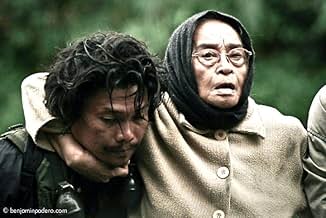Ajouter une intrigue dans votre langueFollows the hostage crisis of the Dos Palmas kidnappings in the southern Philippines, the life of the hostages whose survivors were freed after an awful year in captivity.Follows the hostage crisis of the Dos Palmas kidnappings in the southern Philippines, the life of the hostages whose survivors were freed after an awful year in captivity.Follows the hostage crisis of the Dos Palmas kidnappings in the southern Philippines, the life of the hostages whose survivors were freed after an awful year in captivity.
- Récompenses
- 2 nominations au total
Katherine Mulville
- Sophie Bernstein
- (as Kathy Mulville)
Timothy Castillo
- Ahmed
- (as Timothy Mabalot)
Chanel Latorre
- Annette Agudo
- (as Chanel La Torre)
Histoire
Commentaire à la une
I saw this film as part of the the Competition section of the Berlinale film festival 2012. Running time was exactly 2 hours, in my opinion much too long given its contents. On the plus side, we had interesting shots of the jungle, we met all sorts of small and large animals, and we observed native ways to cure wounds. It helped us pass the time, yet a fair bit of editing away some scenes would be helpful in appreciating this film.
The story is based on the Abu Sayyaf kidnapping (2001) of a group of tourists from the Dos Palmas Resort in the province of Palawan. One of them got through the whole ordeal and wrote a book about her experiences. During the first four days the full group was cramped together in a small boat. The rest of the journey covers a whole year finding ones way through the jungle, a seemingly endless series of moves from village to village.
The first days after the kidnapping exposed linguistic as well as cultural/religious differences. The latter was clearly demonstrated when a box full of bibles was thrown overboard, deemed "useless ballast" by the kidnappers. Another example was when a Christian group member loudly insisted on burying a fellow member, though they really had no time for it, and leaving the body behind would have improved their chances for survival. There were more such cases, each offering the chance to feel with both sides of the argument.
The journey itself took more than a year. It is difficult to imagine how a civilized person can survive that long, devoid of any preparation or training to cope with that environment. The ordeal is not easy to watch from your comfy chair, from time to time pondering how you would behave yourself in such a situation, most other times considering yourself lucky to be at a safe distance.
Starting with small time jumps in the beginning, zooming in on the group and its cultural differences, it was not more than logical that time jumps became larger and larger near the end (the last 20 minutes covered day 157 and day 220).
The hostages are clearly a trade object. Gradually it grew smaller during the journey, due to ransoms being paid. Some group members were out of luck, however, because of their homelands (like the US) having a policy to never comply with ransom demands. And of course there were casualties, some from fever or after an accident, while others were killed during encounters with the army because of (mostly failed) rescue attempts.
All in all, I cannot recommend this film. I appreciate the effort made in showing us the jungle, the people living there, and various strange (to us) beliefs and traditions we observe. No effort at all is made to clarify the relationships with the army (indeed rescue attempts, or is there more to it?). Similarly, I wondered how the kidnappers are regarded by the inhabitants of the successive villages they visit (friend, enemy, neutral?). Or are they simply tolerated while they carry the most gun power? And which rule in which religion or culture deems a forced marriage to be an acceptable alternative for rape? This may seem a recommendation to increase the running time of this film even more than it already is, in order to make room for such additional information. But that need not be, since some scenes can easily be shortened without missing anything, for example the convoluted way they occupy a hospital.
The story is based on the Abu Sayyaf kidnapping (2001) of a group of tourists from the Dos Palmas Resort in the province of Palawan. One of them got through the whole ordeal and wrote a book about her experiences. During the first four days the full group was cramped together in a small boat. The rest of the journey covers a whole year finding ones way through the jungle, a seemingly endless series of moves from village to village.
The first days after the kidnapping exposed linguistic as well as cultural/religious differences. The latter was clearly demonstrated when a box full of bibles was thrown overboard, deemed "useless ballast" by the kidnappers. Another example was when a Christian group member loudly insisted on burying a fellow member, though they really had no time for it, and leaving the body behind would have improved their chances for survival. There were more such cases, each offering the chance to feel with both sides of the argument.
The journey itself took more than a year. It is difficult to imagine how a civilized person can survive that long, devoid of any preparation or training to cope with that environment. The ordeal is not easy to watch from your comfy chair, from time to time pondering how you would behave yourself in such a situation, most other times considering yourself lucky to be at a safe distance.
Starting with small time jumps in the beginning, zooming in on the group and its cultural differences, it was not more than logical that time jumps became larger and larger near the end (the last 20 minutes covered day 157 and day 220).
The hostages are clearly a trade object. Gradually it grew smaller during the journey, due to ransoms being paid. Some group members were out of luck, however, because of their homelands (like the US) having a policy to never comply with ransom demands. And of course there were casualties, some from fever or after an accident, while others were killed during encounters with the army because of (mostly failed) rescue attempts.
All in all, I cannot recommend this film. I appreciate the effort made in showing us the jungle, the people living there, and various strange (to us) beliefs and traditions we observe. No effort at all is made to clarify the relationships with the army (indeed rescue attempts, or is there more to it?). Similarly, I wondered how the kidnappers are regarded by the inhabitants of the successive villages they visit (friend, enemy, neutral?). Or are they simply tolerated while they carry the most gun power? And which rule in which religion or culture deems a forced marriage to be an acceptable alternative for rape? This may seem a recommendation to increase the running time of this film even more than it already is, in order to make room for such additional information. But that need not be, since some scenes can easily be shortened without missing anything, for example the convoluted way they occupy a hospital.
Meilleurs choix
Connectez-vous pour évaluer et suivre la liste de favoris afin de recevoir des recommandations personnalisées
Détails
- Date de sortie
- Pays d’origine
- Sites officiels
- Langues
- Aussi connu sous le nom de
- Captured
- Sociétés de production
- Voir plus de crédits d'entreprise sur IMDbPro
Box-office
- Montant brut mondial
- 83 135 $US
- Durée2 heures
- Couleur
- Mixage
- Rapport de forme
- 1.85 : 1
Contribuer à cette page
Suggérer une modification ou ajouter du contenu manquant






































